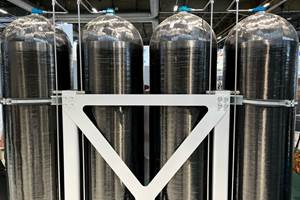Additive manufacturing: The past, present — and future — of composites
A regular CW columnist and the chief commercialization officer for the Institute for Advanced Composites Manufacturing Innovation (IACMI), Dale Brosius offers this insightful look into why it's unwise to use the terms "3D printing" and "additive manufacturing" interchangeably.
Nary a week goes by without the appearance in publications ranging from major magazines, such as Businessweek and Forbes, to Internet newsletters of articles about the latest advances in 3D printing — and how these advances are transforming the industrial world. If one extrapolates the enthusiasm expressed by the writers of these articles, we should then expect that, within the next two decades, everything will be printed on demand.
Without a doubt, 3D printing technology is advancing quickly, and it is capable of building parts with features not possible by traditional manufacturing methods, including internal channels with multiple curvatures. It obviates the need for traditional tooling and the time and cost associated with such tools, especially for low volumes. Most of the work to date has been with smaller, metallic parts, using powder-based processes. GE Aviation (Cincinnati, Ohio), for example, has touted work it has done on specialized components for jet engines. On the polymer side, Airbus (Toulouse, France) used 3D printing for more than 1,000 parts on the A350 XWB from SABIC’s (Pittsfield, MA, US) ULTEM 9085, a polyetherimide plastic with excellent FST (fire, smoke and toxicity) properties. For large parts, Oak Ridge National Laboratory (Oak Ridge, TN, US) has used 3D printing of chopped carbon fiber-filled thermoplastics to fabricate the entire bodies of several automobiles, including a replica of the famous Shelby Cobra.
Recently, I have heard the terms “3D printing” and “additive manufacturing” used interchangeably, as if they are one and the same thing, and as if the whole idea of additive manufacturing hasn’t existed before. I’m reminded of Venn diagrams from my university logic class — all 3D printing is, indeed, additive manufacturing, but not all additive manufacturing is 3D printing. For composites, this is a pretty significant distinction.
Additive manufacturing has been around for millennia — the ancient pyramid builders used an additive approach, placing blocks, layer by layer, incorporating tombs and passageways as they erected those giant monoliths. Advantages of additive approaches include minimal generation of offal, or scrap, that has to be disposed, recycled or otherwise handled. That’s in stark contrast to subtractive manufacturing like the carving of the statue of David or Mount Rushmore — removing rock until the desired features and dimensions are obtained. Milling of molds from steel billets, or wingskins from thick slabs of aluminum, are common examples of subtractive manufacturing. Material removed in subtractive processes must either be recycled or becomes landfill.
Although I can’t be sure what qualifies as the first additive manufacturing process in composites, the use of chopper guns that incorporate in-line mixing and deposition of polyester resin and glass fibers has existed for at least four decades. Applied layer by layer, and with the capability to vary thickness, this process, initially done by hand, has been highly automated since. Prepreg hand layup, it could be argued, is an additive process, but the fact that one starts with rectangular roll goods and cuts patterns, resulting in a fair amount of scrap, means that it starts out subtractive. The same is true of most preforming processes based on textile roll goods. To address these concerns, automated tape laying (ATL) and automated fiber placement (AFP) emerged and are true additive processes, because each results in minimal trim scrap.
As an industry, we still have a lot of work to do in this area, especially if we are to extend AFP/ATL beyond aerospace to industrial applications. As I have written before, the wind industry is able to manually place fabrics in molds at a very high rate, so machine costs have to decline substantially to make economic sense. To penetrate automotive markets, such machines must also be able to lay down materials on smaller components rapidly and at low capital costs. Several companies globally are working on this, not just on thermoset prepregs, but also thermoplastic tapes and dry fiber tows for RTM preform manufacture.
Lest one think I am negative about the potential of 3D printing, let me be clear: I see numerous opportunities for this technology in the composites industry, and it should become part of our collection of additive manufacturing processes. I would like to see the technology applied to long discontinuous materials or even continuous fibers via an inline pultrusion technique. Both should be suitable for many composite structures. Building tooling, either in composites or metal, seems an obvious approach to shorten lead times and reduce costs. But if we are to make composites the ubiquitous materials we hope them to be, additive manufacturing in all its forms must continue to evolve.
Related Content
Recycling hydrogen tanks to produce automotive structural components
Voith Composites and partners develop recycling solutions for hydrogen storage tanks and manufacturing methods to produce automotive parts from the recycled materials.
Read MoreMcLaren celebrates 10 years of the McLaren P1 hybrid hypercar
Lightweight carbon fiber construction, Formula 1-inspired aerodynamics and high-performance hybrid powertrain technologies hallmark this hybrid vehicle, serve as a springboard for new race cars.
Read More“Structured air” TPS safeguards composite structures
Powered by an 85% air/15% pure polyimide aerogel, Blueshift’s novel material system protects structures during transient thermal events from -200°C to beyond 2400°C for rockets, battery boxes and more.
Read MoreThermoplastic composites: Cracking the horizontal body panel nut
Versatile sandwich panel technology solves decades-long exterior automotive challenge.
Read MoreRead Next
Developing bonded composite repair for ships, offshore units
Bureau Veritas and industry partners issue guidelines and pave the way for certification via StrengthBond Offshore project.
Read MoreVIDEO: High-volume processing for fiberglass components
Cannon Ergos, a company specializing in high-ton presses and equipment for composites fabrication and plastics processing, displayed automotive and industrial components at CAMX 2024.
Read MorePlant tour: Daher Shap’in TechCenter and composites production plant, Saint-Aignan-de-Grandlieu, France
Co-located R&D and production advance OOA thermosets, thermoplastics, welding, recycling and digital technologies for faster processing and certification of lighter, more sustainable composites.
Read More





















